|
Sharing Thanks
by Bob Brooke
Thanksgiving Day greetings were usually sent to
friends and relatives as an invitation or as a “keep in touch” greeting,
but it was the early postcards that carried the message to millions of
homes each year for the cost of one cent. But people sent Thanksgiving
Day greetings long before the postcard came on the scene. The oldest
Thanksgiving Day greeting dates back to 1881.
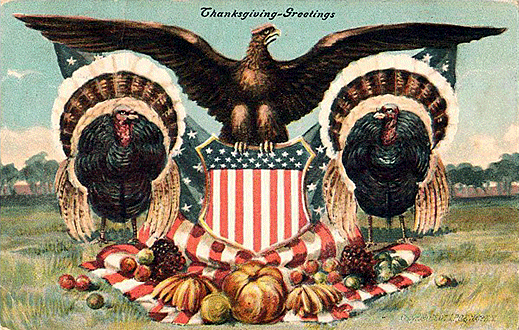
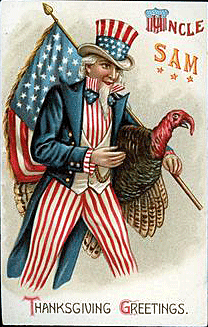 The
postcards of Thanksgiving Day have long been collectible because of
their patriotic. historic, and comedic themes. Uncle Sam appears on some
of them, often sharing honors with, of all things, a turkey. Long
recognized as a distinctively American motif, Uncle Sam was a natural
for these since he’s an American icon. The American eagle and “Old
Glory,” also share the spotlight, but the most recurrent topic of
postcard illustrations is an American family of the past celebrating
Thanksgiving. The
postcards of Thanksgiving Day have long been collectible because of
their patriotic. historic, and comedic themes. Uncle Sam appears on some
of them, often sharing honors with, of all things, a turkey. Long
recognized as a distinctively American motif, Uncle Sam was a natural
for these since he’s an American icon. The American eagle and “Old
Glory,” also share the spotlight, but the most recurrent topic of
postcard illustrations is an American family of the past celebrating
Thanksgiving.
Much of the iconography of the vintage Thanksgiving postcards created
between 1898 and 1918 comes from the myths surrounding the first
Thanksgiving. Images feature Pilgrims in quaint old-fashioned
white-and-black garb, pointed hats, white bonnets, and buckled shoes. In
contrast, postcards often showed the Indians as caricatures, barely
dressed with brightly colored face paint, feathers, headdresses, and
beads. Modern-day historians say none of this is remotely true to the
real event.
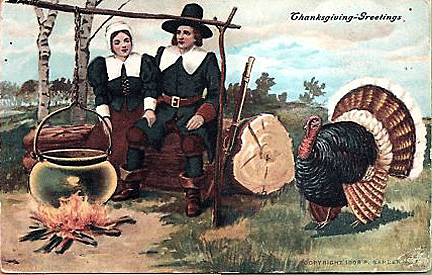 Novelty
cards were also popular. These ranged from add-ons of turkeys and
Pilgrims, to mechanicals of turkeys with kaleidoscopic tails. Novelty
cards were also popular. These ranged from add-ons of turkeys and
Pilgrims, to mechanicals of turkeys with kaleidoscopic tails.
Of all the holiday cards published, only Christmas was more family
oriented than Thanksgiving Day. Some of these postcards featured
children confronting or being chased by an aggressive turkey.
 Of
all the publishers involved who marketed postcards for this holiday,
collectors favor those produced by the firm of John Winsch, who
published postcards for just 10 years. He began business at a time when
the postcard was beginning to lose its appeal with the general public
and overseas imports store flooded the shelves of shops. Of
all the publishers involved who marketed postcards for this holiday,
collectors favor those produced by the firm of John Winsch, who
published postcards for just 10 years. He began business at a time when
the postcard was beginning to lose its appeal with the general public
and overseas imports store flooded the shelves of shops.
One of the minor features of the Payne-Aldrich tariff act of July 1,
1909, was its restriction on English and European postcards and paper
goods in general. This restraint on imports probably gave Winsch the
idea of setting up shop.
Winsch’s company,located in Stapleton, New York, began producing quality
novelty postcards to fill the gap left by the lack of foreign imports.
At a time when postcards were selling for a penny each retail, or six
for a nickel, Winsch's charged two for five cents, even when the
Woolworth chain of five-and-dimes reduced prices even lower, to way. His
peak year was 1911.
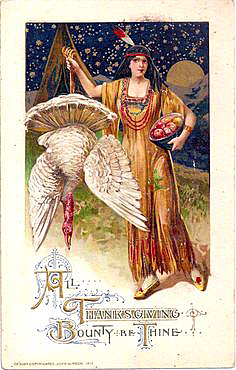 Samuel
Schumucker, known for his Halloween cards, created some of his very best
Thanksgiving designs for John Winsch. Some of the best Winsch cards ha
die-cut pop-up parts called projections. Samuel
Schumucker, known for his Halloween cards, created some of his very best
Thanksgiving designs for John Winsch. Some of the best Winsch cards ha
die-cut pop-up parts called projections.
The copyright years for the Winsch’s Thanksgiving Day postcards run from
1910 through 1915, and then there’s a lapse of time until the last date,
1920. World War I was undoubtedly responsible, most likely due to a
shortage of paper and other supplies. The Winsch series favored by most
collectors is one of the 1912 copyrights. This magnificent set of six
pictures are of different Thanksgiving Days of the past.
Another important publisher of Thanksgiving postcards was Raphael Tuck &
Sons. Their New York City branch distributed at least 17 different sets
between 1906 and 1914. Like most of their holiday greeting cards, people
bought them for mailing to friends and relatives. This is why so many of
Tuck's Thanksgiving Day postcards can be found in used condition. Many
of the sets went through repeated printings, often with tiny variations
of design or wording, and were aggressively marketed for several years.
Retailers continued to sell leftover stocks well into the early 1920s.
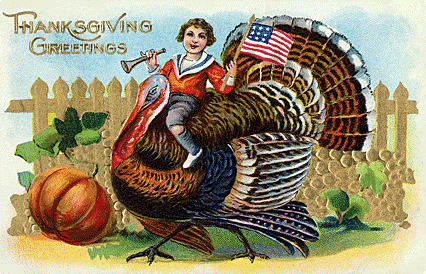 Of
the 17 sets, series 123 of 24 cards, which includes some illustrations
by R.J. Wealthy, was by far the most plentiful. It appeared on store
racks through the East, South, and Midwest every Thanksgiving season for
many years after its first printing in 1910. Scenes of turkeys dominated
the illustrations—they appeared driving a car, standing in an open
pumpkin field, strolling down a lane, in parade formation, or being
chased by a man wielding a hatchet. Some of the printings had gold
borders. Of
the 17 sets, series 123 of 24 cards, which includes some illustrations
by R.J. Wealthy, was by far the most plentiful. It appeared on store
racks through the East, South, and Midwest every Thanksgiving season for
many years after its first printing in 1910. Scenes of turkeys dominated
the illustrations—they appeared driving a car, standing in an open
pumpkin field, strolling down a lane, in parade formation, or being
chased by a man wielding a hatchet. Some of the printings had gold
borders.
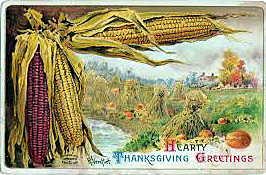 Leubrie
& Elkus, identified by the initials "L&E," sold postcards for most
holidays, including Thanksgiving. H.B. Griggs, whose "HBG" signature is
familiar to many collectors, designed almost their entire line.. Part of
the artist’s 400, or so, designs included approximately seven sets of
six cards each for Thanksgiving. More than any other artists, Griggs
interjected a great comedic touch into her often quirky Thanksgiving Day
cards. Leubrie
& Elkus, identified by the initials "L&E," sold postcards for most
holidays, including Thanksgiving. H.B. Griggs, whose "HBG" signature is
familiar to many collectors, designed almost their entire line.. Part of
the artist’s 400, or so, designs included approximately seven sets of
six cards each for Thanksgiving. More than any other artists, Griggs
interjected a great comedic touch into her often quirky Thanksgiving Day
cards.
Other publishers heavily involved in printing Thanksgiving postcards for
pre-1920 America were E. Nash, which was responsible for at least 27
different sets, PFB, a much admired German publisher who exported three
sets of six into this country, Fred Lounsbury, whose two sets were on
sale in 1907 and 1908, and P. Sander with seven sets.
Even though top postcard publishers produced Victorian Thanksgiving
postcards, they’re possibly the least collected of holiday postcards.
This is possibly because the colors and images tend to be more subdued.
To read
more of my articles, please
visit
my Web site.
< Back
to Collectibles Archives
Next
Article >
|
